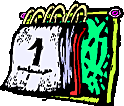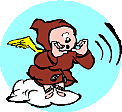With The Commentary of the RABAM

(Commentary of the RABAM In Italics)
The following is excerpted from my award winning* Parshas Emor Drasha
Why do we prepare so intensively for Pesach? According to Rabeinu Tam, we commemorate slavery in Egypt by spending six hours marching up and down the stairs to the attic to bring down the Pesach dishes while our wives stand over us barking orders (those amharatzois), like the Egyptian taskmasters.
Rabeinu Tam = Tasty Rabbi; a mediaeval commentator (Tam also means straightforward).
Pesach dishes = due to the stringencies of kashrus for Peysach, many households have a complete set of dishes and utensils used only during the Passover week. Amharatzois = Illiterates (literally: people of the land, hence uneducated peasant types, simple folk, etc.).
It is considered a mark of kedusha to remember the misery of our
ancestors in Mitzrayim by trying to duplicate it EXACTLY in the days
leading up to the holiday, including the abuse of slaves.
Meanwhile, rachmana litzlan, our wives absolutely exhaust themselves watching the cleaning lady prepare for Pesach.
Rachmana litzlan = an appeal to mercy from the Aybishter. Appropriate in this context, when we remember what Hashem did for us when we were slaves in Egypt, but the cleaning lady’s claim may have precedence.)
The RAMBAM in Mishnah Torah asks an incisive question: Instead of selling our chametz to a goy, why can’t we just temporarily sell our religion to a goy? This way, he can have the opportunity to get the mitzvah of celebrating Yetzias Mitzrayim, while we get to eat a little traifus, paint easter eggs, and have relations with a hot shiksa for seven days (eight days in Chutz La’aretz). But the RAMBAM concludes that if a goy had to eat Matzah for eight days, he would end up hating the Jews even more than he already does.
(Rambam = Rabbi Moses Ben Maimon, than whom none was wiser save Moses Our Teacher (Mi Moishe ad Moishe, lo kam ki Moishe - From Moses to Moses, there was none like Moses).
Mishneh Torah = Repetition of Torah; The Rambam’s masterpiece (also called the Yad HaChazaka - the strong hand), composed after Maimonides settled in Egypt. Selling our chametz to a Goy = because it is forbidden to have, own, or profit by leavened material (chametz, chometz) from before the beginning of the Passover holiday till after it is over, being eight days in chuts le arets (outside the land – outside Israel), seven within the land. This is based on the concept that dates and times as determined by declaring the new moon in Yerushalayim may not be noted or transmitted with full accuracy to the communities in golus (exile).
Rav Saadya Gaon (Rabeinu Saadya Ben Yosef, b. 892, d.942, a grammarian, linguist, and rosh yeshiva, who is largely remembered for lambasting the
Karaites) opines that the second day is halacha Moishe miSinai (a Mosaic law received at Sinai).
End up hating... = because he (the Goy) would understand for an extra day how much kedusha (holiness) he is missing out on. It is a chillul to inculcate such bitter envy in a Gentile.
In truth, why do we stop our Peshach cleaning at our abode and our
cars? A Gemarrah In Masheches Peshachim daff chuff aleph, amud baiz asks: Why don’t we clean out our bodies of the Chometz we pump into them 51 weeks a year? Indeed, Rav Ashi holds that this is the reason that bechorim fast Erev Pesach, and that to get the full mitzvah, people should stick their finger’s down their throats during bedikas chometz.
And in our cars = we are obligated to remove those MacDonalds wrappers and old pizza boxes before picking up the mechutanim for the seder, taking care to wipe the dashboard clean of crumbs (chometz!) and grease-stains. It is also a good idea to vacuum the vehicle or have the upholstery professionally shampooed, as the eye-sight of a mother-in-law improves with age, while her tolerance lessens. But when she finally passes on we will realize what a saint she was. Her kugel is the best, every bite an exquisite revelation, a miracle of “utter delicious!”, and by the way you are not good enough for her daughter.
Gemara in Maseches Pesachim = Pesachim, the third tractate in Mo’ed, in the first part, Pesach Rishon, goes into excruciating detail on ridding chometz from our abodes and our lives, in every conceivable way. You really don’t want to know all the details, trust me! Gross! I’m not even going to mention where we’re supposed to hunt for chometz with that feather! And I’m not touching wooden spoons ever again!
Note that many modern poskim (Halachic decisors) opine that a good scrubbing with a rag dipped in household cleanser is more than adequate,
provided that the cleanser be allowed to soak into every crack and crevice, which will make whatever chometz is thus drenched both unfit for any possible consumption, and something which a dog will not eat (one of the conditions of acceptability).
Rav Ashi = Ashi Bar Simai (352 - 427), the head of the academy at Sura and the compiler of the Gemara.
Fasting before Peysach = Taanit Bechorim; It is an obligation for every first-born son to fast on Erev Peysach, in remembrance of the saving of the first-born of Israel when G-d passed over them while killing the first born of Egypt.
How do we know that the Aybishter himself killed all the first-born of Egypt, and did not delegate? Because it is written: (Shemos 12:12) “For I will go through the land of Egypt that night, and will whack all the firstborn in the land of Egypt, both man and beast, and all the gods of Egypt I will judge over - I am the LORD.” (Ve avarti ve’erets Mitsrayim ba laila haze ve hikeiti chol bechor be erets Mitsrayim, me adam ve ad behema u-vechol elohei Mitsrayim e’ese shefatim ani Adonai).
(12:13) “And the blood shall to you be a sign upon the houses where you dwell, and when I see the blood, I will pass over you, and there shall no plague to destroy you, when I punish the land of Egypt.” (Ve haya ha dam lachem leot al ha batim asher atem sham veraiti et hadam ufasachti aleichem ve lo yihye vachem negef lemashchit be hakoti be erets Mitsrayim) It is because the Aybishter passed over our dwellings that the holiday is called Pass-over.
It is illustrative to read what happens next (Shemos 12:29): “And it came to pass at midnight, that the LORD destroyed all the firstborn in the land of Egypt, from the first-born of Pharaoh sitting on his throne unto the firstborn of the prisoner in the pokey, and all the firstlings of the kine.” (Va yehi bachatsi ha laila va Adonai hika chol bechor be erets Mitsrayim, mi bechor Paro ha yoshev al kiso ad bechor ha shevi asher be veit ha bor ve chol bechor behema).
(12:30) “And Pharaoh got up in the night, and all his servants, and all Egypt; and there was a great wailing in Egypt, as there was not a single house without a victim. “ (Va yakam Paro laila hu ve chol avadav ve chol Mitsrayim va tehi tseaka gedola be Mitsrayim, ki ein bayit asher ein sham met). This was the tenth affliction visited upon the Egyptians, and the only one effected by the presence of Hashem, the other nine being by agents. The killing of the first-born was by direct intervention, and the drop that finally broke the camels bucket.
Finger --- = A hiddur mitzvah (embellishment of the commandment; doing more than is strictly required) to expel all chometz from one’s person. Syrup of ipecac may also be used (repeatedly).
Bedikas chometz = Getting rid of all chometz, to make the house fit for Passover.)
But further in the Gemarra, Rav Yosi disagrees, saying that since the food is already eaten, we hold that food cannot be eaten a second time, so there is no such requirement. However, Rav Yosi does go on to tell a story of how one year he told his wife that he needed her help cleaning for Pesach, since halacha required him to expel ALL possible bodily fluids. And due to her extreme gullibility, she helped him three times that night. What an Aishess Chayill. Unfortunately, he slept through much of the seder the next night, so he never dared to do it again.
Rav Yossi = A great scholar who lived over sixteen centuries ago in
the Holy Land, one of the two redactors of the Yerushalmi, being the Talmud of the land, as opposed to the Bavli (the Babylonian Talmud, a more detailed work); we take account of the Yerushalmi, but follow the Bavli.
Halacha = the codes of law as derived from the Torah and expounded upon in Talmud.
Bodily fluids = because exposure to fluids starts the leavening process; if the fluids are salty (smell to make sure), leavening is considered to be instantaneous.
Aishes chayil = an ideal woman, as praised in a song by Shlomo HaMelech (King Solomon) which is sung on Friday night to laud the efforts of the woman of the house. The great woman who is worth singing about. A strong woman, a woman of great fortitude.
My personal belief is that celebrating Yetzias Mitzrayim is a wonderful opportunity to spend time with the einiklach. Beyond cleaning, you get the mitzvah of preparing the matzois and the ka’arah. During the Seder you are unified with all of Klal Yisroel in celebration. And after the Seder, while cleaning up, you lament the fact that your damn mother-in-law wasn’t accidentally left in Mitzrayim.
Yetzias Mitzrayim = redemption from Egypt.
Matzois = a type of unleavend crackerois, made in a process that may take no more than eighteen minutois.
Ka’arah, Karah = the seder plate, with its arrangement of items:
-- Maror, which is the bitterness of our lives in Egypt;
-- Zeroa, the shankbone symbolizing the sacrifice of the lamb whose blood on the lintel was a marking on that night;
-- Charoses (a fruit and nut paste), the mud and mortar with which we built edifices for Pharaoh;
-- Chazeres, bitter vegetables to eat with the lamb;
-- Karpas, celery or parsley which symbolizes spring and hope, which we dip in salt water for the tears we shed in Egypt;
-- and the Beitza, the egg which stands for hope, rebirth, spring, new life, and completion.
Klal Yisroel = the entirety of the descendants of Jacob.
Damn mother-in-law = whose presence at the seder reminds us that Egypt was NOT the last word in suffering. Ouch!! Sorry darling!
Ah Gutten Yuntif, You Minuval
* - I felt good that day so I bought myself a nice “award”, which I watched late at night with my bashert, just to get her in the mood to do a mitzvah




